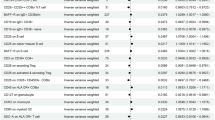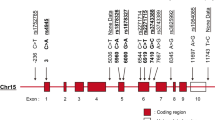Summary:
Oestrogen receptors mediate the cellular response to oestrogens and related compounds and promote a wide range of effects on haemopoiesis. Polymorphisms of the oestrogen receptor genes have previously been associated with variation in bone mineral density, likelihood of fractures, risk of developing Alzheimer's disease, endometrial cancer and response to hormone replacement therapy. We examined the polymorphisms in both ERα and ERβ genes in 108 patients receiving a bone marrow transplant from an HLA-matched sibling donor, and compared ER genotype with outcomes of occurrence of graft-versus-host disease (GVHD) and survival using logistic regression analysis. Polymorphism of ERα (presence of the PX haplotype (PvuII–XbaI RFLP) of intron 1), but not ERβ, in the patient genotype associates with occurrence of acute GVHD and with lower overall survival, following correction for known clinical and genotypic risk features. Analysis of ER genotype prior to transplant might therefore inform on a patient's likelihood of developing post-transplant complications. Variation in transplant performance because of ER genotype suggests an underlying role for oestrogens in the pathophysiology of transplant-related complications, and suggests that oestrogen-related therapy may offer a new modality of post-transplant support.
This is a preview of subscription content, access via your institution
Access options
Subscribe to this journal
Receive 12 print issues and online access
$259.00 per year
only $21.58 per issue
Buy this article
- Purchase on Springer Link
- Instant access to full article PDF
Prices may be subject to local taxes which are calculated during checkout

Similar content being viewed by others
References
Issa JP, Zehnbauer BA, Civin CI et al. The estrogen receptor CpG island is methylated in most hematopoietic neoplasms. Cancer Res 1996; 56: 973–977.
Dechering K, Boersma C, Mosselman S . Estrogen receptors α and β: two receptors of a kind? Curr Med Chem 2000; 7: 561–576.
Schroeder C, Gibson L, Nordstrom C, Beug H . The estrogen receptor co-operates with the TGFα receptor (c-erbB) in regulation of chicken erythroid progenitor self-renewal. EMBO J. 1993; 12: 951–960.
Medina KL, Kincade PW . Pregnancy related steroids are potentially negative regulators of B lymphopoiesis. Proc Natl Acad Sci USA 1994; 91: 5382–5386.
Kalu DN, Salerno E, Liu CC et al. Ovariectomy induced bone loss and the hematopoietic system. J Bone Miner Res 1993; 23: 145–161.
Jilka RL, Hangoc G, Girasole G et al. Increased osteoclast development after estrogen loss: mediation by interleukin-6. Science 1992; 257: 88–91.
Thurmond TS, Murante FG, Staples JE et al. Role of estrogen receptor alpha in hematopoietic stem cell development and B lymphocyte maturation in the male mouse. Endocrinology 2000; 141: 2309–2318.
Stein B, Yang MX . Repression of the interleukin-6 promoter by estrogen receptor is mediated by NF-κB and C/EBP-β. Mol Cell Biol 1995; 15: 4971.
Becherini L, Gennari L, Masi L et al. Evidence of a linkage disequilibrium between polymorphisms in the human estrogen receptor α gene and their relationship to bone mass variation in postmenopausal women. Hum Mol Genet 2000; 9: 2043–2050.
Sano M, Inoue S, Hosoi T et al. Association of estrogen receptor dinucleotide repeat polymorphism with osteoporosis. Biomed Biophys Res Commun 1995; 217: 378–383.
Gennari L, Becherini L, Masi L et al. Vitamin D and estrogen receptor allelic variants in Italian postmenopausal women: evidence of multiple gene contribution to bone mineral density. J Clin Endocrinol Metab 1998; 83: 939–944.
Willing M, Sowers M, Aron D et al. Bone mineral density and its change in white women: estrogen and vitamin D receptor genotypes and their interaction. J Bone Miner Res 1998; 13: 695–705.
Kobayashi S, Inoue S, Hosoi T et al. Association of bone mineral density with polymorphism of the estrogen receptor gene. J Bone Miner Res 1996; 11: 306–311.
Mahonen A, Turunen A-M, Kroger H, Maempaa PH . Estrogen receptor gene polymorphism is associated with bone mineral density in perimenopausal Finnish women. J Bone Miner Res 1997; 12(Suppl. 1): T614.
Hoshino S, Hosoi T, Miyao M et al. Identification of a novel polymorphism of estrogen receptor-α gene that is associated with calcium excretion in urine. J Bone Miner Metab 2000; 18: 153–157.
Ji Y, Urakami K, Wada-Isoe K et al. Estrogen receptor gene polymorphisms in patients with Alzheimer's disease, vascular dementia and alcohol-associated dementia. Dement Geriatr Cogn Disord 2000; 11: 119–122.
Mattila KM, Axelman K, Rinne JO et al. Interaction between estrogen receptor 1 and the epsilon4 allele of apolipoprotein E increases the risk of familial Alzheimer's disease in women. Neurosci Lett 2000; 282: 45–48.
Weiderpass E, Persson I, Melhus H et al. Estrogen receptor alpha gene polymorphisms and endometrial cancer risk. Carcinogenesis 2000; 21: 623–627.
Herrington DM, Howard TD, Hawkins GA et al. Estrogen-receptor polymorphisms and effects of estrogen replacement on high-density lipoprotein cholesterol in women with coronary disease. N Engl J Med 2002; 346: 967–974.
Ogawa S, Hosoi T, Shiraki M et al. Association of estrogen receptor β gene polymorphism with bone mineral density. Biochem Biophys Res Commun 2000; 269: 537–541.
Rosenkranz K, Hinney A, Ziegler A et al. Systematic mutation screening of the estrogen receptor beta gene in probands of different weight extremes: identification of several genetic variants. J Clin Endocrinol Metab 1998; 83: 4524–4527.
Cavet J, Middleton PG, Segall M et al. Recipient tumour necrosis factor-α and interleukin-10 gene polymorphism's associate with early mortality and acute graft-versus-host-disease severity in HLA-matched sibling bone marrow transplants. Blood 1999; 94: 3941–3946.
Cavet J, Dickinson AM, Norden J et al. Interferon gamma and interleukin six gene polymorphism associate with graft versus host disease in HLA-matched sibling bone marrow transplantation. Blood 2001; 98: 1594–1600.
Cullup H, Dickinson AM, Jackson GH et al. Donor interleukin-1 receptor antagonist genotype associated with acute graft versus host disease in HLA-matched sibling allogeneic transplants. Br J Haematol 2001; 113: 1–8.
Middleton PG, Cullup H, Dickinson AM et al. Vitamin D receptor gene polymorphism associates with graft versus host disease and survival in HLA-matched sibling allogeneic bone marrow transplantation. Bone Marrow Tansplant 2002; 30: 223–228.
Dickinson AM, Hrmadnikova I, Sviland L et al. Use of a skin explant model for predicting GVHD in HLA-matched bone marrow transplants – effect of GVHD prophylaxis. Bone Marrow Transplant 1999; 24: 857–863.
Storb R, Deeg JH, Whitehead J et al. Methotrexate and cyclosporin compared with cyclosporin alone for prophylaxis of acute graft versus host disease after marrow transplantation for leukemia. N Engl J Med 1986; 314: 729–735.
Glucksberg H, Storb R, Fefer A et al. Clinical manifestations of graft-versus-host disease in human recipients of marrow from HLA-matched sibling donors. Transplantation 1974; 18: 295–304.
Atkinson K, Horowitz MM, Gale RP et al. Consensus among bone marrow transplanters for diagnosis grading and treatment of chronic graft-versus-host disease. Committee of the International Bone Marrow Transplant Registry. Bone Marrow Transplant 1989; 4: 247–254.
Dickinson AM, Cavet J, Cullup H et al. GvHD risk assessment in haematopoietic stem cell transplantation – Role of cytokine gene polymorphisms and an in vitro human skin explant model. Human Immunol 2001; 62: 1266–1276.
Grandien K . Determination of transcription start sites in human estrogen receptor gene and identification of a novel, tissue-specific, estrogen receptor-mRNA isoform. Mol Cell Endocrinol 1996; 116: 207–212.
Bollig A, Miksicek RJ . An estrogen receptor-α splicing variant mediates both positive and negative effects on gene transcription. Mol Endocrinol 2000; 14: 634–649.
Grainger DJ, Metcalfe JC . Tamoxifen: teaching an old drug new tricks. Nat Med 1996; 2: 381.
Nagy E, Berczi I . Immunomodulation by tamoxifen and pergolide. Immunopharmacology 1986; 12: 145.
Sthoeger ZM, Bentwich Z, Zinger H, Mozes E . The beneficial effect of the estrogen antagonist, tamoxifen, on experimental systemic lupus erythematosus. J Rheumatol 1994; 21: 2231.
Dayan M, Zinger H, Kalush T et al. The beneficial effects of treatment with tamoxifen and anti-oestradiol antibody on experimental systemic lupus erythematosus are associated with cytokine modulations. Immunology 1997; 90: 101–108.
Hirayama F, Shih JP, Awgulewitsch A et al. Clonal proliferation of murine lymphopoietic progenitors in culture. Proc Natl Acad Sci USA 1992; 89: 5907–5911.
Urbano-ispizua A, Rozman C, Martinez C et al. Rapid engraftment without significant graft versus host disease after allogeneic transplantation of CD34+ selected cells from peripheral blood. Blood 1997; 89: 3967–3973.
Dickinson AM, Reid MM, Abinun M et al. In vitro T–cell depletion using CAMPATH 1M for mismatched BMT for severe combined immunodeficiency (SCID). Bone Marrow Transplant 1997; 19: 323–329.
Acknowledgements
We thank the clinical team involved in the bone marrow transplant programme at the Royal Victoria Infirmary, Newcastle upon Tyne, particularly Professor SJ Proctor, Dr A Lennard and Dr PJ Hamilton. This work was supported by the Tyneside Leukaemia Research Association (AMD & HC) and the LRF (UK) (JC and JN).
Author information
Authors and Affiliations
Rights and permissions
About this article
Cite this article
Middleton, P., Norden, J., Cullup, H. et al. Oestrogen receptor α gene polymorphism associates with occurrence of graft-versus-host disease and reduced survival in HLA-matched sib-allo BMT. Bone Marrow Transplant 32, 41–47 (2003). https://doi.org/10.1038/sj.bmt.1704090
Received:
Accepted:
Published:
Issue Date:
DOI: https://doi.org/10.1038/sj.bmt.1704090
Keywords
This article is cited by
-
Predicting survival using clinical risk scores and non-HLA immunogenetics
Bone Marrow Transplantation (2015)
-
The role of non-HLA gene polymorphisms in graft-versus-host disease
International Journal of Hematology (2013)



